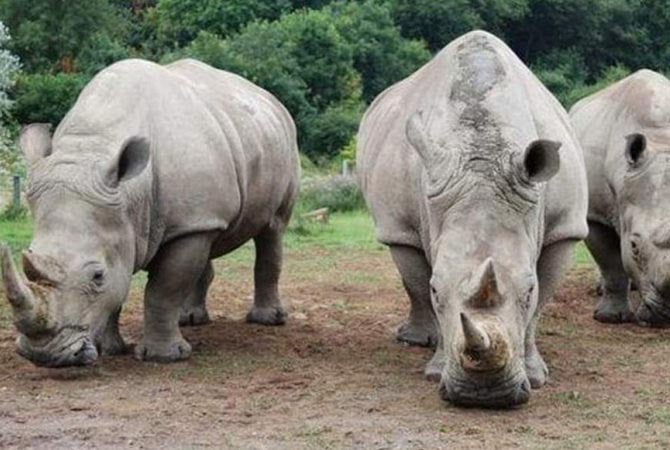UWA to reintroduce white rhinos in West Nile reserve

Tourists watch rhinos feed at Ziwa Rhino Sanctuary in 2021. PHOTO/COURTESY
What you need to know:
- With a maximum capacity of 40, the sanctuary currently has more than 40 rhinoceros. This means that excess rhinoceros needed relocation to alternative spaces.
A long-standing move by the Uganda Wildlife Authority (UWA) to reintroduce white rhinoceros to Ajai Wildlife Reserve in Madi-okollo District in West Nile Region has started to take shape. This comes after UWA last Friday completed the two-day successful relocation of 200 kobs and 50 buffaloes to the reserve.
The kobs and buffaloes were drawn from Kabwoya Wildlife Reserve and Murchison Falls National Game Park, the Monitor established.
The exercise, according to the authority, is aimed at repopulating the wildlife reserve and to suppress the overgrown vegetation before the introduction of Southern White Rhinoceros there.
“By reintroducing common species such as kobs and buffaloes, UWA aims to enhance the reserve’s capacity to manage diverse wildlife populations effectively. Rhinoceros are grazers, they eat the grass but the kobs and buffaloes we have taken there eat everything including tree branches,” Mr Bashir Hangi, the UWA spokesman said.
While the buffaloes are currently being translocated, UWA said reintroducing the kobs and buffaloes adds variety to the itinerary of the reserve for tourists.
“We don’t want to keep the rhinos there alone, we want a variety of animals if we are to improve the tourism of the area. We cannot look at rhinoceros alone,” Mr Hangi added.
This publication also established that relocating rhinoceros to Ajai Wildlife Reserve will relieve the already overstretched Ziwa Rhino Sanctuary in Nakasongola District.
With a maximum capacity of 40, the sanctuary currently has more than 40 rhinoceros. This means that excess rhinoceros needed relocation to alternative spaces.
“We are going to pick several rhinoceros from Ziwa Rhino Sanctuary in Nakasongola District because the carrying capacity of the sanctuary has now reached its maximum. We want to keep Ziwa as a breeding space. So, we shall not take away all the rhinos, we shall leave behind some so that they can continue breeding. Once the young ones are grown, we distribute them to other bigger spaces,” Mr Bashir said.
To conclude that rhinoceros can survive within Ajai Wildlife Reserve, UWA conducted a feasibility study five years ago, which scored the reserve and Murchison Falls National Game Park as the best alternative facilities to host the rhinoceros.
“We undertook a study that recommended some sites and scored them accordingly, but Ajai scored high, and even Murchison and Kidepo. We can’t go ahead to spread the rhinos everywhere, we shall have to systematically study their progress at Ajai once we introduce them there,” Mr Hangi said.
He further said squaring on the reserve is also intended to revive tourism in the West Nile, a region that ranks lowest in terms of attractions.
“West Nile has been doing badly in terms of tourism. When you look at the tourism circuits, tourists go and end at Murchison Falls National Game Park through the Acholi Sub-region to Karamoja Sub-region which has Kidepo Valley National Game Park,” he said.
Whereas rhinoceros will be free-ranging at Ajai reserve, UWA now plans to establish a full sanctuary for the animals that require a very high level of protection.
“By reintroducing key species to Ajai Wildlife Reserve, UWA is not only enhancing the ecological balance but also setting the stage for the successful reintroduction of rhinoceros shortly.” Mr Sam Mwandha, UWA executive director, said.
While emphasising the significance of the translocation exercise in fostering sustainable tourism and community engagement, Mr Mwandha said the translocation effort underscores UWA’s commitment to biodiversity conservation and ecosystem restoration.
“The translocation of wildlife to Ajai Wildlife Reserve is a testament to our dedication to responsible tourism and inclusive conservation practices. This initiative will not only elevate the tourism potential of the reserve but also ensure equitable benefits for local communities through revenue sharing mechanisms,” he said.
Once a thriving wildlife protected area and a home to the now critically endangered white rhinos, Ajai Wildlife Reserve, which sits on land measuring approximately 160 square kilometres, has experienced a significant reduction in the number of animal species.
“The lawlessness and poor management of the reserve in the 1970s and 1980s led to the local extinction of some keystone species in the reserve including the northern white rhinoceros while the significant decline in the population of other species was also registered. The reintroduction of key species such as kobs and buffalos, and later the Southern White Rhinoceros, demonstrates the significant strides taken by UWA towards restoring the ecological balance and safeguarding Ajai’s biodiversity for generations to come,” UWA said in a statement.
Over the past decade, UWA implemented an intervention to repopulate wildlife-protected areas with dwindling populations.
The objectives of this programme encompass ecosystem balance, tourism enhancement, as well as preservation of aesthetic and cultural values, among others.
This initiative has successfully led to the repopulation of several areas, including Kidepo Valley, Lake Mburo, and Murchison Falls national parks, as well as Katonga, Pian Upe, and Kabwoya wildlife reserves.
In November last year, UWA unveiled a roadmap indicating how the long-awaited reintroduction of the white rhinoceros back to Ajai Wildlife Reserve, its original habitat, will be accomplished by 2025.
Mr John Makombo, the Director in-charge of Conservation at UWA, told Madi-Okollo leaders at a council meeting last week that buffaloes and kobs will deliberately be reintroduced into the reserve as pioneer stock of animals in preparing the reserve for the reintroduction of white rhinoceros.
Background
In November last year, UWA unveiled a roadmap indicating how the long-awaited reintroduction of the white rhinoceros back to Ajai Wildlife Reserve, its original habitat, will be accomplished by 2025.




